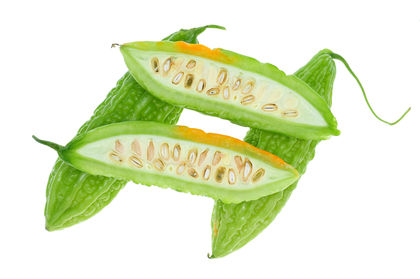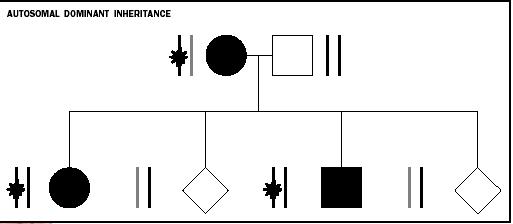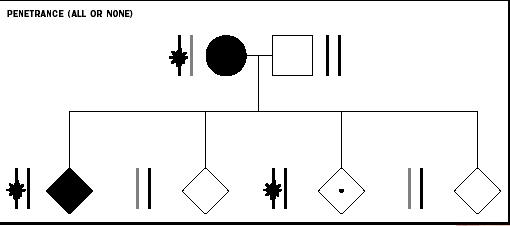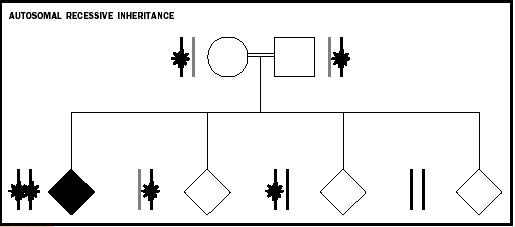Pedigrees and Modes of Inheritance

A pedigree is a diagram that depicts the blood relationships of family members, as well as which individuals express the trait or disorder under study. Construction of a pedigree is often the first step in the identification of a gene variant that causes a particular disease or trait. Several terms are encountered in pedigree analyses.
Phenotype, Genotype, and Alleles
A phenotype is an observable trait that is the expression of a gene combination, or genotype. Eye color, blood group, and the symptoms of inherited diseases are examples of phenotypes. Chromosomes , and therefore genes, occur in pairs in a diploid organism, such as a human. An individual inherits one copy of each gene from his or her mother and another copy from the father. A gene can exist in alternate forms, called alleles . A gene may have many alleles, but a person can only have two copies of the same allele, or two different alleles, for a particular gene. An individual who inherits two copies of the same allele is homozygous ; inheriting two different alleles is termed heterozygous .
Pedigree Symbols
The figures in this article show symbols commonly used in pedigrees. Squares represent males, circles represent females, and diamonds depict individuals of unknown or, for reasons of confidentiality, disguised gender. A double line between parents indicates consanguineous marriages (between blood relatives) (see Figure 3). Filled symbols represent individuals who display a certain trait, such as an inherited disease. Bars next to the symbols represent genetic loci, and different alleles are color-coded. Diseasecausing mutations are shown as stars or crosses. Symbols that are half filled indicate heterozygous individuals, but often this information isn't known.


Modes of Inheritance
A pair of alleles can show one of three modes of inheritance. Augustinian monk and botanist Gregor Mendel (1822–1884) demonstrated these patterns of inheritance using pea plant crosses. The modes of inheritance are autosomal dominant , autosomal recessive, and X-linked. To simplify the discussion of these different forms, the trait used in the following text will be a hereditary disease.
Autosomal Dominant
In individuals with an autosomal dominantly inherited condition (Figure 1), one mutation is sufficient to cause disease. Statistically, an affected individual is therefore expected to have 50 percent affected and 50 percent unaffected offspring. However, each child has the same chance (50 percent) of inheriting the mutated gene. That is, if the first two children are affected, the next two are not necessarily going to be unaffected. "Autosomal" indicates genes on the chromosomes that do not carry genes that determine sex, and so both males and females are affected in successive generations. Usually, the disease does not occur in the offspring of unaffected individuals. Rarely, an autosomal-dominant mutation does not cause disease, perhaps because of the effects from other genes. Such a mutation is said to be incompletely penetrant (Figure 2). Penetrance is an all-or-none phenomenon: the disease is either present or absent. In contrast, expressivity refers to the degree of phenotypic expression. For example, the trait of extra fingers or toes, called polydactyly, is incompletely penetrant, because some individuals with affected parents and children have the normal numbers of fingers or toes. Polydactyly is also variably expressive, because affected individuals vary in the numbers of extra digits.
Autosomal Recessive
In individuals with an autosomal recessively inherited disease (see Figure 3), both alleles are mutant. Usually, the parents of the affected individual are

X-linked
An X-linked trait is carried on the X chromosome. In pedigrees depicting X-linked inheritance, usually only males are affected and, although affected males may occur in consecutive generations, transmission is always through females. This is based on the fact that males have a single X chromosome (in addition to their Y chromosome), which they always inherit from their mother and will always pass on to their daughters but never to their sons. Females, on the other hand, have two X chromosomes. Therefore, they can be carriers of an X-linked mutation, but in most cases are phenotypically unaffected because they have a second (nonmutated) X chromosome, compensating for whatever loss of function is caused by the mutated gene.
Mitochondrial
Some additional genetic material in humans is contained in the mitochondrial genome, and some diseases result from mutations in mitochondrial genes. Only females can transmit mitochondrial diseases because sperm cells rarely contribute mitochondria to the oocyte at fertilization . Therefore, a mitochondrial disease is typically passed from an affected mother to all her children, but not from an affected man to any of his children. Many mitochondrial disorders cause muscle fatigue, because muscle cells contain thousands of mitochondria that provide energy for contraction.
SEE ALSO Genetic Analysis ; Genetic Diseases ; Mendel, Gregor ; Patterns of Inheritance
Christine Klein
Bibliography
Goss, S. J., and H. Harris. "New Method for Mapping Genes in Human Chromosomes." Nature 255 (1975): 680–684.
Passarge, Eberhard. Color Atlas of Genetics. New York: Thieme, 1995.
Watson, James D., Michael Gilman, Jan Witkowski, and M. Zoller. Recombinant DNA, 2nd ed. New York: W. H. Freeman and Company, 1993.